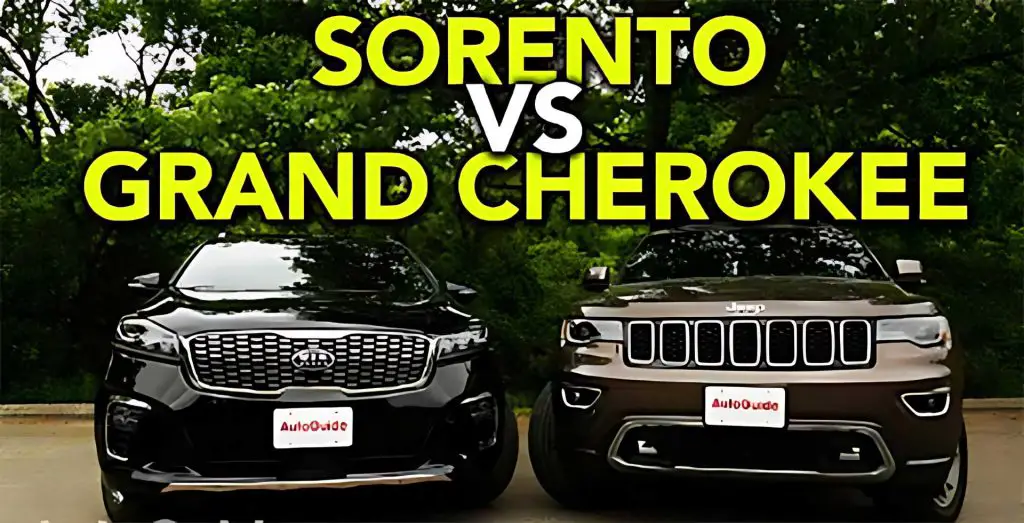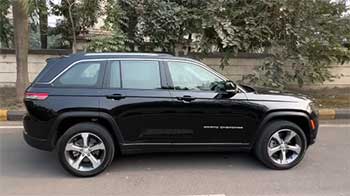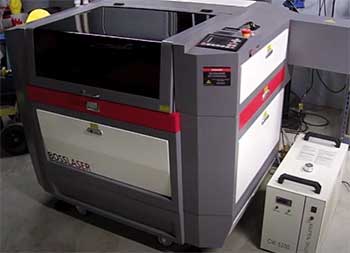I’ve been shopping for a midsize SUV, and let me tell you, it’s a jungle out there. Two models that keep popping up are the Jeep Grand Cherokee and the Kia Sorento. Both have their fans, but which one’s right for you?
In this article, I’m breaking down their key features, weighing the pros and cons, and sharing my take on what makes each SUV shine—or stumble. From performance to practicality, I’ll help you decide which of these rides fits your life best.

Comparison Table: Jeep Grand Cherokee vs. Kia Sorento
| Feature | Jeep Grand Cherokee | Kia Sorento |
| Starting MSRP | $38,490 | $33,405 |
| Seating Capacity | 5 | 7 |
| Cargo Space (cu. ft.) | 37.7 (seats up), 70.8 (seats folded) | 12.6 (seats up), 70.8 (seats folded) |
| Base Engine | 3.6L V6, 293 hp | 2.5L 4-cylinder, 191 hp |
| Fuel Economy (MPG) | 19 city / 26 highway | 23 city / 31 highway |
| Towing Capacity | Up to 7,200 lbs (V8) | Up to 3,500 lbs (turbo) |
| Reliability Rating | 3.5/5.0 (RepairPal) | 4.0/5.0 (RepairPal) |
| Warranty | 3 years / 36,000 miles | 5 years / 60,000 miles |
| Safety Rating (NHTSA) | 4.66/5.0 | 4.49/5.0 |
| Off-Road Capability | Excellent (4×4 systems, Trailhawk trim) | Moderate (AWD available) |
My Journey Comparing These SUVs
When I set out to compare the Jeep Grand Cherokee and Kia Sorento, I wanted to approach it like a real buyer—someone who’s juggling budget, family needs, and a bit of wanderlust. I’ve test-driven both, pored over specs, and talked to owners to get a feel for what these SUVs bring to the table.
The Jeep Grand Cherokee has that rugged, go-anywhere vibe, while the Kia Sorento feels like a practical family hauler with a touch of modern flair. Let’s break it down and see how they stack up.
Performance: Power vs. Efficiency
Jeep Grand Cherokee: The Powerhouse
I’ll start with the Jeep Grand Cherokee because, wow, this thing’s got some muscle. Its base engine is a 3.6L V6 pumping out 293 horsepower, and if you’re feeling extra, the available 5.7L HEMI V8 cranks it up to 357 horsepower. During my test drive, the V6 felt plenty peppy for highway merges and city cruising. The Grand Cherokee’s eight-speed automatic transmission shifts smoothly, though I noticed a slight lag when pushing it hard from a standstill.

For off-road enthusiasts like me, the Grand Cherokee’s 4×4 systems—especially in the Trailhawk trim—are a dream.
I took one through a muddy trail, and it tackled rocky inclines with ease, thanks to its 610mm wading depth and robust all-season tires. Towing? No sweat.
The V8 can haul up to 7,200 pounds, perfect for my buddy’s boat or a camper for weekend getaways.
But here’s the catch: fuel economy. The Grand Cherokee gets 19 MPG city and 26 MPG highway with the V6. I wasn’t thrilled about filling up more often, especially with gas prices creeping up. The 4xe plug-in hybrid (PHEV) option, with 375 horsepower and 470 lb.-ft. of torque, offers better efficiency, but it’s pricey—starting around $60,000.
Kia Sorento: The Efficient Cruiser
The Kia Sorento, on the other hand, leans into efficiency. Its base 2.5L four-cylinder engine delivers 191 horsepower, which felt adequate but not thrilling during my drive. If you want more zip, the turbocharged 2.5L four-cylinder bumps it up to 281 horsepower. It’s no V8, but it’s enough for daily commutes and school runs. The eight-speed dual-clutch transmission in the turbo model shifts crisply, though I noticed it could feel jerky in stop-and-go traffic.

Fuel economy is where the Sorento shines. It gets 23 MPG city and 31 MPG highway with the base engine, saving me a few bucks at the pump compared to the Jeep.
The Sorento’s hybrid and PHEV options are even better, with the PHEV offering up to 30 miles of electric-only range. I drove the hybrid, and it was smooth and quiet—perfect for city life.
Off-road? The Sorento’s AWD system is decent for light snow or gravel roads, but it’s not built for serious trails. Towing capacity maxes out at 3,500 pounds with the turbo engine, which is fine for smaller trailers but can’t match the Jeep’s heft.
Interior: Comfort and Space
Jeep Grand Cherokee: Premium but Compact
Stepping into the Grand Cherokee, I was impressed by its upscale vibe, especially in higher trims like the Summit Reserve. The leather seats, simulated wood trim, and soft-touch materials gave it a near-luxury feel. The front seats were comfy, though I found the second row a bit tight with 38.2 inches of legroom. If you’re hauling adults back there, they might grumble on long trips.
Cargo space is solid, with 37.7 cubic feet behind the second row and 70.8 cubic feet with the seats folded. I easily fit my camping gear and a cooler, but the Sorento’s three-row setup gives it an edge for families.
The Grand Cherokee’s tech is a highlight—up to five touchscreens, including a 10.1-inch infotainment display, head-up display, and even a night vision system in top trims. The Uconnect system was intuitive, and Apple CarPlay/Android Auto worked seamlessly.
Kia Sorento: Family-Friendly Space
The Sorento’s interior feels modern and practical. The base LX trim has cloth seats and some hard plastics, but higher trims like the SX Prestige add leather and a 12.3-inch touchscreen that looks sharp. I found the front seats super comfortable, and the second row’s 41.7 inches of legroom was a win for my taller friends. The third row, though, is best for kids—it’s cramped for adults.
Cargo space is a mixed bag. With all seats up, you get just 12.6 cubic feet, barely enough for groceries. Fold the second and third rows, and you match the Jeep’s 70.8 cubic feet. The Sorento’s seven-seat configuration is a big plus for families, and I loved the captain’s chairs in the second row for easy third-row access.
The infotainment system is user-friendly, with a 10.25-inch touchscreen on most trims, though the purple-heavy interface was a bit quirky for my taste. The 12-speaker Bose audio system in the SX Prestige was a treat for music lovers.
Discover More: Bilstein B6 vs. B8 Coilovers
Safety: Keeping You Secure
Jeep Grand Cherokee: Top Marks
Safety is a big deal for me, and the Grand Cherokee delivers. It earned a 4.66/5.0 NHTSA safety rating and an IIHS Top Safety Pick award. Standard features include automatic emergency braking, blind-spot monitoring, and lane-keeping assist.
The Summit Reserve’s Active Driving Assist (Level 2 semi-autonomous driving) was a game-changer on my highway test drive, keeping me centered in my lane with minimal effort. Eight airbags, including knee airbags, add peace of mind.
Kia Sorento: Solid but Slightly Behind
The Sorento’s no slouch, with a 4.49/5.0 NHTSA rating and a five-star ANCAP rating from 2020. Its Drive Wise suite includes automatic emergency braking, lane-following assist, and rear cross-traffic alert. I liked the junction-turning assist, which helped avoid collisions at intersections. Seven airbags are standard, but it lacks the Jeep’s knee airbags. The adaptive cruise control with stop-and-go was smooth, though it didn’t feel as polished as the Jeep’s system.
Reliability and Ownership Costs
Jeep Grand Cherokee: A Mixed Bag
Reliability is where I started to question the Grand Cherokee. RepairPal gives it a 3.5/5.0 rating, ranking 15th out of 26 midsize SUVs. The average annual repair cost is $666, which is about average, but I heard from owners about occasional electrical issues and suspension wear. The warranty—3 years or 36,000 miles—feels short compared to the Sorento. Five-year ownership costs are higher, with IntelliChoice estimating $7,125 to $13,965 more than the Sorento.
Kia Sorento: The Reliable Choice
The Sorento scores a 4.0/5.0 on RepairPal, ranking 12th out of 26 compact SUVs. Its average annual repair cost is $533, lower than the Jeep, and owners I spoke with raved about its dependability. The 5-year/60,000-mile basic warranty and 10-year/100,000-mile powertrain warranty are tough to beat. Consumer Reports recommends the Sorento for its reliability, safety, and performance, while the Grand Cherokee doesn’t get the same nod.
Off-Road Capability: Jeep’s Domain
If you’re like me and love hitting the trails, the Grand Cherokee is in a league of its own. Its 4×4 systems, like Quadra-Trac II and Quadra-Drive II, are built for serious off-roading. I tested the Trailhawk on a rocky hill, and it climbed effortlessly, even with all-season tires. The 4xe PHEV, while not as rugged, still handled light trails well.
The Sorento’s AWD is fine for light snow or gravel roads, but it’s not designed for hardcore off-roading. If you stick to pavement or light adventures, the Sorento’s capable enough, but the Jeep’s the king of the wild.
Price and Value: Budget vs. Premium
The Kia Sorento starts at $33,405, making it more budget-friendly than the Grand Cherokee’s $38,490 base price. Fully loaded, the Sorento SX Prestige AWD hits around $48,990, while the Grand Cherokee Summit Reserve 4xe can climb to $90,000.
For the price, the Sorento offers more seating and a longer warranty, but the Jeep’s premium features and off-road prowess justify its cost for some. I found the Sorento’s value proposition stronger for families, while the Jeep appeals to those wanting luxury and adventure.
Pros and Cons
Jeep Grand Cherokee Pros
- Powerful engine options, including a 357-hp V8 and 375-hp PHEV.
- Exceptional off-road capability with advanced 4×4 systems.
- Premium interior with up to five touchscreens and luxury features.
- High towing capacity (up to 7,200 lbs).
- Strong safety ratings and advanced driver assistance systems.
Jeep Grand Cherokee Cons
- Higher starting price ($38,490).
- Below-average fuel economy (19/26 MPG).
- Tight second-row legroom (38.2 inches).
- Average reliability (3.5/5.0) and higher repair costs ($666/year).
- Shorter warranty (3 years/36,000 miles).
Kia Sorento Pros
- Lower starting price ($33,405).
- Better fuel economy (23/31 MPG, plus hybrid/PHEV options).
- Spacious interior with seven-seat option and 41.7 inches of second-row legroom.
- Strong reliability (4.0/5.0) and lower repair costs ($533/year).
- Longer warranty (5 years/60,000 miles, 10 years/100,000 miles powertrain).
Kia Sorento Cons
- Less powerful base engine (191 hp).
- Limited off-road capability compared to Jeep.
- Cramped third row for adults.
- Smaller cargo space with seats up (12.6 cubic feet).
- Slightly lower safety rating (4.49/5.0).
My Take: Which SUV Wins?
After test-driving both and crunching the numbers, I lean toward the Kia Sorento for its value, reliability, and family-friendly features. The seven-seat option, better fuel economy, and longer warranty make it a practical choice for daily life. But if you crave adventure or luxury, the Jeep Grand Cherokee’s power, off-road capability, and upscale interior are hard to resist. It really comes down to your priorities—family hauler or trail conqueror?
Considering Similar Vehicles? Kia Sorento vs. Mazda CX-50
Frequently Asked Questions (FAQ)
It depends on your needs. The Sorento is better for families, with seating for seven, better fuel economy, and stronger reliability. The Grand Cherokee excels for off-roading, power, and luxury features.
The Sorento has a less powerful base engine (191 hp), limited off-road capability, a cramped third row, and smaller cargo space with seats up (12.6 cubic feet).
Comparable SUVs include the Hyundai Santa Fe, Toyota Highlander, and Honda Pilot, offering similar seating, features, and family-oriented designs.
The Kia Sorento ranks 12th out of 26 compact SUVs with a 4.0/5.0 reliability rating from RepairPal, above average for its class.
Conclusion
Choosing between the Jeep Grand Cherokee and Kia Sorento is like picking between a rugged road trip and a comfy family vacation. If you’re after power, off-road thrills, and a premium vibe, the Grand Cherokee’s your ride. If you need space, efficiency, and reliability for your daily grind, the Sorento’s got you covered. Think about what matters most—your wallet, your adventures, or your family’s comfort—and you’ll know which SUV to drive home.

